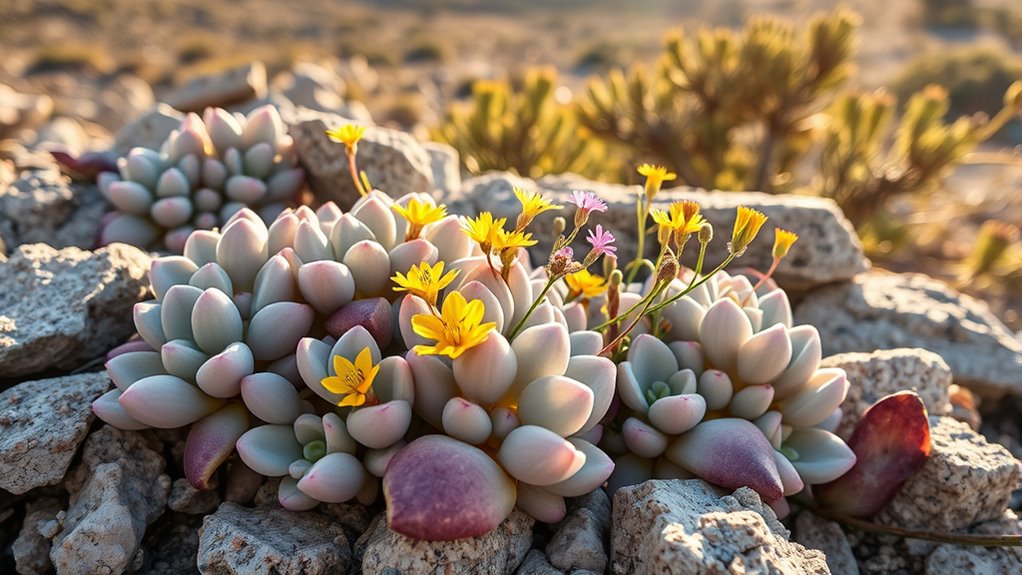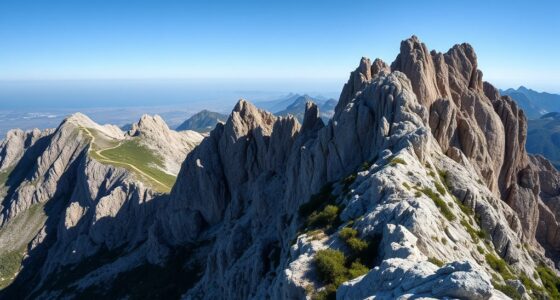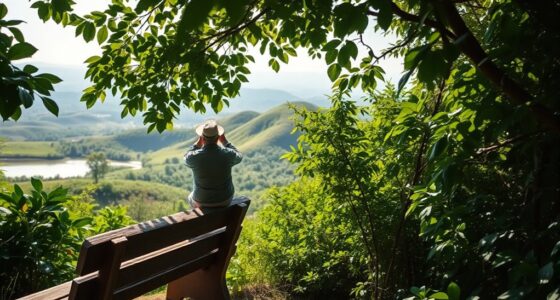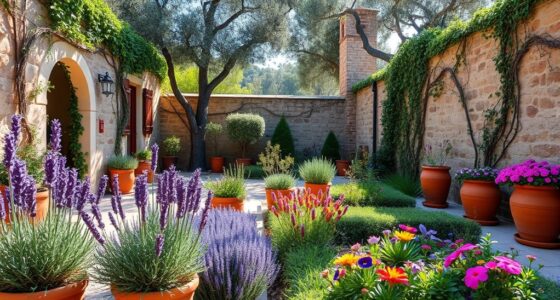Explore Sardinia’s rich plant life, home to over 340 endemic species that flourish in mountain, coastal, and freshwater habitats. You’ll find diverse families like Amaryllidaceae and Apiaceae, showcasing unique evolutionary traits. The island’s varied landscapes support Mediterranean flora such as holm oaks, pines, and aromatic herbs, while mountain refuges host rare endemics. Understanding these plants reveals Sardinia’s ecological and biogeographical wonders—if you keep exploring, you’ll uncover even more fascinating botanical insights.
Key Takeaways
- Sardinia hosts approximately 341 endemic plant taxa, mainly in mountains, coasts, and freshwater habitats.
- Endemics belong to families like Amaryllidaceae, Apiaceae, and Campanulaceae, reflecting island-specific evolution.
- Key endemic species include *Anchusa crispa* subsp. *maritima*, *Paeonia sandrae*, and *Cephalaria squamiflora* subsp. *bigazzii*.
- The island’s diverse geology and microclimates create specialized niches supporting rich endemic flora.
- Conservation efforts focus on protecting fragile populations from habitat loss, invasive species, and climate change impacts.
Endemic Plant Species of Sardinia

Sardinia’s unique landscape fosters a rich diversity of endemic plant species, with approximately 341 taxa found nowhere else. These endemics represent about 15% of the island’s native vascular flora and belong to 53 plant families. Many of these species have limited distributions, often confined to specific habitats like mountain slopes, coastal areas, or freshwater zones, creating biodiversity hotspots. Their restricted ranges result from Sardinia’s geological history, climate variability, and isolation, which promote speciation. Endemic plant families such as Amaryllidaceae, Apiaceae, and Campanulaceae contribute significantly to this diversity. You’ll find endemics such as *Anchusa crispa* subsp. *maritima* along northern coasts, *Paeonia sandrae* in the northwest, and *Cephalaria squamiflora* subsp. *bigazzii* in eastern zones. These plants reflect Sardinia’s complex biogeographical past and are crucial to the island’s unique ecological identity. Additionally, ongoing conservation efforts aim to protect these fragile species from threats like habitat loss and climate change.
Major Plant Families and Their Unique Endemics
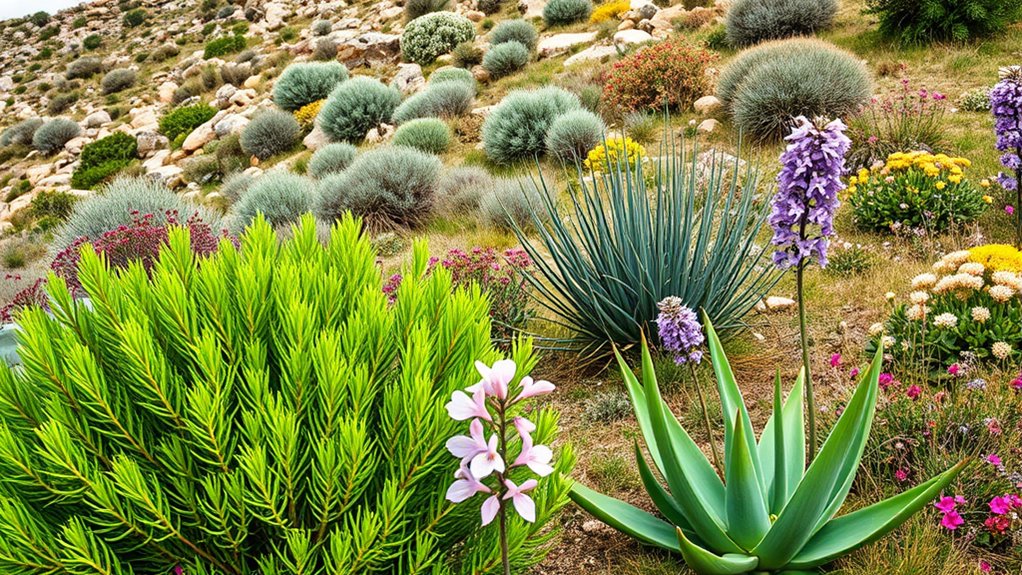
- Reflects significant contribution to western Mediterranean diversity
- Demonstrates island-specific evolution and diversification
- Shows adaptation to local environments, from coastal to inland
- Provides clues about evolutionary processes shaping island flora
- Molecular studies of Sardinian endemic species have revealed complex phylogenetic relationships and historical biogeography, shedding light on the origins and diversification patterns of these unique plants.
Distribution Patterns and Biogeographical Insights

The distribution patterns of endemic vascular plants in Sardinia reveal how topography, geology, and climate shape where these species occur. You’ll notice higher endemic plant richness at specific elevation bands, especially in mountain areas that serve as refugia. The island’s diverse geological substrates and microclimates create habitat heterogeneity, supporting niche specialization. Sardinia’s biogeographical position as part of the Tyrrhenian Islands macro-hotspot drives high endemism rates, with many species being island or Tyrrhenian shared endemics. Its history of isolation, glacial refugia, and fluctuating climate foster both ancient relicts and recent endemics. Rugged terrains and complex landforms reduce human impact, allowing endemic species to thrive in less disturbed, microclimatically favorable zones. The terrain’s mountainous nature significantly influences species distribution, shaping Sardinia’s unique biogeographical landscape and endemic plant distribution.
Conservation Challenges and Protected Areas
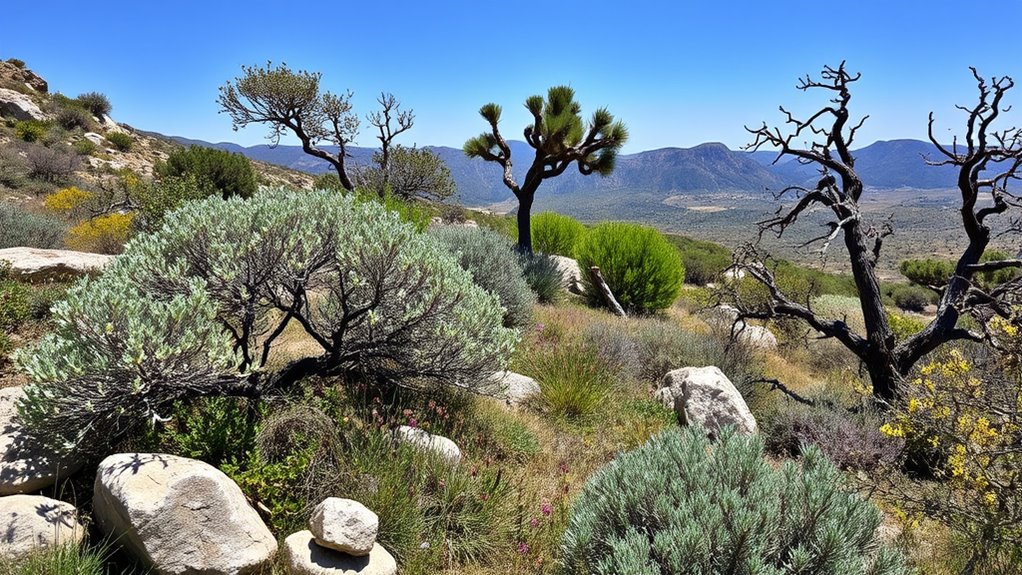
Conservation challenges for Sardinian flora are pressing, as many endemic plants face imminent risks of extinction. Small, isolated populations and restricted habitats make species highly vulnerable. Human activities like habitat destruction from agriculture, urbanization, and tourism worsen these threats, while climate change shifts habitats and stresses species with narrow niches. Invasive species threaten native plants through competition and hybridization. Many local extinctions have occurred, yet knowledge gaps hinder effective action. Understanding the drivers of extinction can help prioritize conservation efforts, which is crucial for maintaining biodiversity. Additionally, the limited genetic diversity within small populations reduces their resilience to environmental changes and diseases. Genetic diversity is fundamental for adaptive capacity and long-term survival of these species.
Protected areas aim to conserve these plants, but gaps in enforcement and management limit their success. Key refuges in mountainous regions host high endemism, but small populations remain vulnerable. Prioritizing efforts involves:
- Improving monitoring and research
- Strengthening legal protections
- Enhancing habitat connectivity
- Using models to identify high-risk areas
Common Mediterranean Flora on the Island
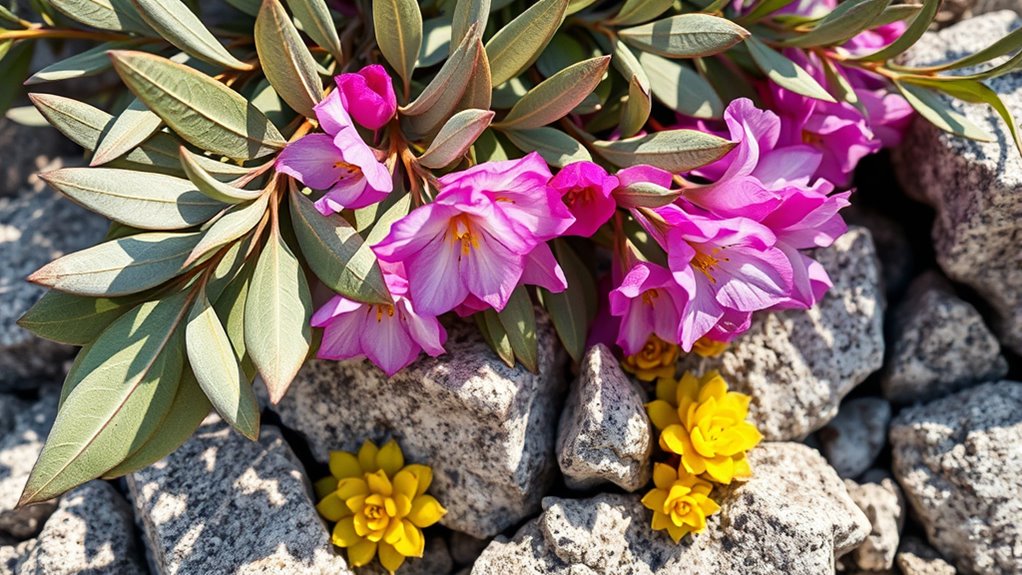
Have you ever wondered what plants define Sardinia’s Mediterranean landscapes? You’ll find evergreen trees like holm oak (*Quercus ilex*) dominating forests and the iconic cork oak (*Quercus suber*) essential for cork production. Aleppo pines (*Pinus halepensis*) thrive along coasts and dry inland areas, while Phoenician (*Juniperus phoenicea*) and Red junipers (*Juniperus oxycedrus*) grow on rocky slopes. Shrubs such as rosemary, myrtle, and arbutus form the Mediterranean maquis. You’ll also notice deciduous trees like black poplar along riverbanks and chestnuts in upland forests. Aromatic herbs—including thyme, lavender, and oleander—cover scrublands. Sardinia’s flora showcases a mix of endemic species, like *Plagius flosculosus*, and widespread plants adapted to dry, rocky, and moist habitats, defining the island’s rich botanical landscape. The island’s natural environment remains largely uncontaminated, supporting a diverse array of plant species. This pristine environment also helps preserve native plant diversity, which is crucial for maintaining the island’s ecological balance.
Frequently Asked Questions
How Can I Identify Sardinian Endemic Plants in the Wild?
To identify Sardinian endemic plants in the wild, focus on their distinctive features like unique flower patterns, colors, and leaf textures. Look for plants in specific habitats such as Mediterranean maquis, rocky slopes, or limestone outcrops. Pay attention to flowering seasons, especially spring, and note their growth forms—shrubs, small trees, or orchids. Using detailed field guides and observing environmental clues helps guarantee accurate identification of these rare, localized species.
Are There Any Rare Endemic Plants I Can Visit Safely?
Did you know that Sardinia hosts about 15% of its native flora as endemic plants? You can visit several rare endemics safely, especially in protected areas like mountains and coastal reserves. Guided tours help you explore species like *Ribes sardoum* near Oliena or *Aquilegia* species in limited sites. Just stay on trails and respect protected zones to enjoy these unique plants without risking their fragile habitats.
What Are the Best Times of Year to See Endemic Species Flowering?
You’ll have the best chance to see Sardinian endemic plants flowering in spring, mainly from March to April, when many species bloom vividly. Early summer (June to July) offers additional displays, especially along coastal and rocky areas. Late summer through autumn (August to October) also provides opportunities, as some endemics extend their flowering or fruiting periods. Timing depends on microclimates, so plan your visit accordingly for the most vibrant displays.
How Do Local Communities Contribute to Endemic Plant Conservation?
You actively contribute to endemic plant conservation by participating in local field surveys and monitoring programs, helping document species’ distribution and health. Your involvement supports scientific research and early detection of threats like habitat loss or invasive species. You also advocate for protective policies, work with authorities, and promote awareness campaigns. Your efforts ensure that Sardinian endemic plants receive the attention and protection they require for long-term survival.
Can I Cultivate Sardinian Endemic Plants in My Garden?
Did you know 15% of Sardinia’s native flora consists of endemic plants? You can cultivate Sardinian endemics in your garden, but it’s challenging. You’ll need to mimic their natural habitats—soil type, moisture, and light conditions—carefully. Be aware some species are rare and protected, so always use certified nursery plants and avoid wild collection. Proper care can help preserve these unique plants while adding Mediterranean beauty to your space.
Conclusion
As you explore Sardinia’s rich plant life, imagine discovering a rare endemic like the Sardinian bluebell thriving on a hidden hillside. Protecting these unique species guarantees future generations can marvel at their beauty. By supporting conservation efforts and visiting protected areas, you become part of preserving Sardinia’s botanical treasures. Your journey helps keep these vibrant ecosystems alive, allowing their stories to continue blooming for years to come.
